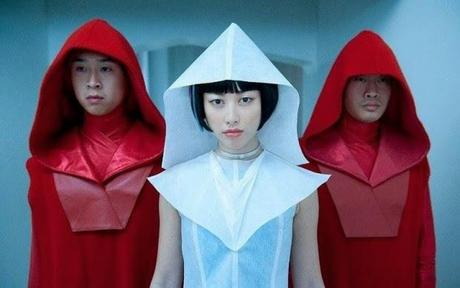by Paul J. Pelkonen

My clone sleeps alone: Doona Bae (center) in Cloud Atlas.
Image © 2012 Warner Brothers Pictures.
This three-hour adaptation of David Mitchell's novel contains six interleaved stories, placed within a narrative framework and depicting different periods of history (past, present and future) in six different locations. Like D.W. Griffith's legendary silent film Intolerance, this picture intercuts between its stories with increasing rapidity over its running time. It's hard to care about these characters in the first hour, but the added-together parts build to a crescendo of emotion that is ultimately hard to resist.
Tom Hanks, Halle Berry, Hugo Weaving, Susan Sarandon, Ben Whishaw, Keith David and Jim Broadbent are the biggest names an all-star cast, moving gleefully in and out of makeup, changing gender and roles between sequences and underlining the movie's message of historical connectivity and a need to return to basic human decency. The three directors are all technically accomplished: the Wachowskis indulge their fetish for big set pieces and CGI, while Mr. Tykwer breathes life into the more intimate sequences.
The film's common threads include the score: introduced as a piece of music ("the Cloud Atlas Sextet") being written by a young, suicidal composer (Ben Whishaw) in 1936, the era where Romanticism was breathing its last and the world was about to be engulfed in the flames of World War II. The thematic material (the music is by Mr. Tykwer and his collaborators Reinhold Hell and Johnny Klimek)is massaged and evolved over the course of the picture, becoming a chamber piece, full orchestral symphony, pounding chase music and even a joyful chorus sung by cloned fast food workers in a 21st century "New Seoul" (Yes it's Korea, but the city name is an excellent pun.)
The Korean sequence (depicting the Christ-like path of a clone (Doona Bae) who is suddenly freed from servitude in a particularly nasty fast-food establishment)) is the movie's most successful, combining elements of futuristic design with the kandy-koated color palette that the Wachowskis last used in Speed Racer. This story keeps you guessing with its twists and turns, creating great emotional impact as Sonmi-451 meets her fate. It is helped by the use of mixed media, digital effects and film-within-film, not to mention a strong and simple performance by Ms. Bae, who goes from a blank doll to a living, breathing being in an arc that recalls Sean Young's performance in Ridley Scott's Blade Runner.
The earliest of all the stories is set in the 19th century, where a callow young man (Jim Sturgess) develops an extraordinary bond with a freed slave (David Gyasi). Other threads in the tapestry include Jim Broadbent's turn as a publisher who must stage a geriatric Great Escape from a terrible nursing home, and a post-apocalyptic story, filmed in Hawaii and written entirely in a futuristic newspeak that makes closed captions necessary for the home viewer.
At one point (about two hours in) Cloud Atlas starts to feel uncomfortably like a pastiche. Mr. Tykwer borrows freely from nuclear conspiracy thriller The China Syndrome for a story set in 1973 featuring a plucky reporter played by Halle Berry. The art-house 1936 arc of the young composer (Ben Whishaw) and his relationship with a duplicitous and ultimately larcenous mentor (Mr. Broadbent) is largely saved by being the source of the film's music. And the futuristic nightmare of "New Seoul" cribs from Blade Runner, The Fifth Element and the Wachowskis' own Matrix trilogy.
Commonalities exist between these diverse stories, with genetic markers, oppression of racial and sexual minorities, cannibalism and the abuse of humans by those in power recurring through all six stories, finding its ultimate expression in an attack by a gang of cannibals (led by Hugh Grant(!) in heavy makeup) at the climax of the post-apocalyptic arc. Much like a symphony by a forgotten and ambitious Romantic composer, this film finds its feet in the last hour, and marches to a stupendous and emotionally satisfying close.

